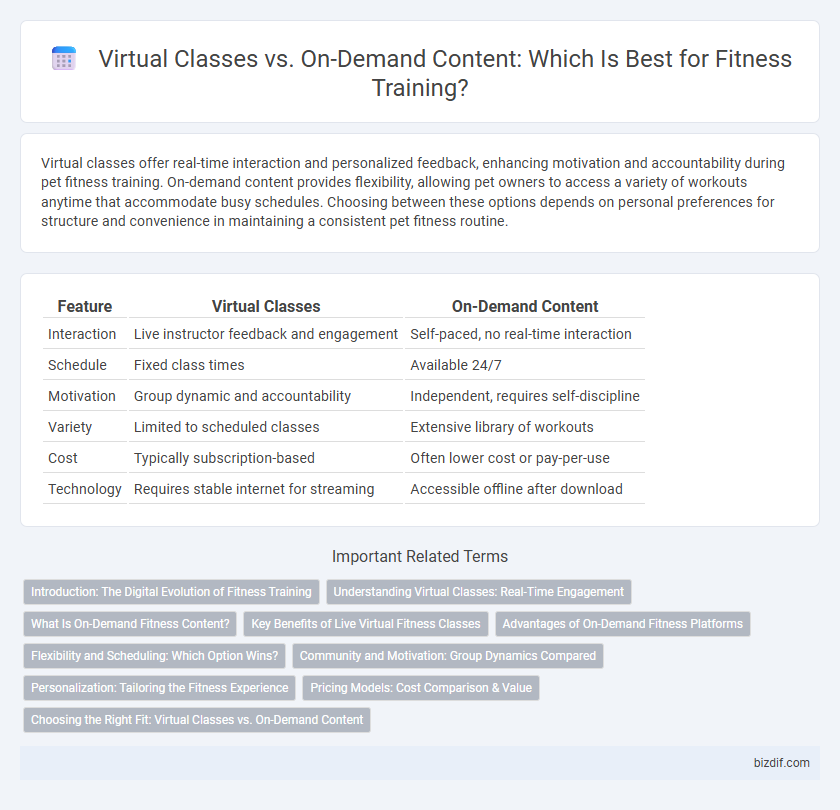Virtual classes offer real-time interaction and personalized feedback, enhancing motivation and accountability during pet fitness training. On-demand content provides flexibility, allowing pet owners to access a variety of workouts anytime that accommodate busy schedules. Choosing between these options depends on personal preferences for structure and convenience in maintaining a consistent pet fitness routine.
Table of Comparison
| Feature | Virtual Classes | On-Demand Content |
|---|---|---|
| Interaction | Live instructor feedback and engagement | Self-paced, no real-time interaction |
| Schedule | Fixed class times | Available 24/7 |
| Motivation | Group dynamic and accountability | Independent, requires self-discipline |
| Variety | Limited to scheduled classes | Extensive library of workouts |
| Cost | Typically subscription-based | Often lower cost or pay-per-use |
| Technology | Requires stable internet for streaming | Accessible offline after download |
Introduction: The Digital Evolution of Fitness Training
Virtual classes offer real-time interaction with instructors and a sense of community, enhancing motivation and accountability. On-demand content provides flexibility, allowing users to access workouts anytime, catering to diverse schedules and fitness levels. Both formats leverage digital platforms to transform traditional fitness training, making exercise more accessible and personalized.
Understanding Virtual Classes: Real-Time Engagement
Virtual fitness classes offer real-time engagement, allowing participants to interact directly with instructors and receive immediate feedback, enhancing motivation and technique correction. Unlike on-demand content, virtual classes provide structured schedules and a sense of community that fosters accountability. This dynamic environment replicates in-person training benefits through live communication, promoting consistent progress and personalized support.
What Is On-Demand Fitness Content?
On-demand fitness content provides users with pre-recorded workout videos accessible anytime, allowing for flexible scheduling and personalized pace. Unlike virtual classes that require real-time participation, on-demand platforms offer a broad range of fitness styles, durations, and difficulty levels tailored to individual preferences. The convenience of on-demand workouts supports consistent training habits, making it an ideal solution for busy lifestyles and varied fitness goals.
Key Benefits of Live Virtual Fitness Classes
Live virtual fitness classes offer real-time instructor feedback, ensuring proper form and reducing injury risk during workouts. Engaging interaction and community support in live sessions boost motivation and accountability for consistent training. The structured schedule of live classes helps participants maintain discipline and achieve fitness goals more effectively.
Advantages of On-Demand Fitness Platforms
On-demand fitness platforms offer unparalleled flexibility by allowing users to access workouts anytime, accommodating varied schedules and time zones. These platforms provide a vast library of diverse training styles and difficulty levels, enabling personalized fitness plans that evolve with user progress. Cost-effectiveness and the absence of live class pressure enhance user motivation and consistency in fitness routines.
Flexibility and Scheduling: Which Option Wins?
Virtual classes offer real-time interaction and scheduled sessions that promote consistency and accountability for fitness enthusiasts. On-demand content provides unparalleled flexibility, allowing users to work out anytime, catering to unpredictable schedules and varying energy levels. Choosing between the two depends on individual preferences for structure versus convenience in maintaining a regular exercise routine.
Community and Motivation: Group Dynamics Compared
Virtual classes foster real-time interaction, creating a strong sense of community that boosts motivation through shared goals and live feedback. On-demand content offers flexibility but lacks the immediate social connection and accountability found in group settings. Group dynamics in virtual classes enhance commitment and encourage consistent participation by leveraging peer support and collective energy.
Personalization: Tailoring the Fitness Experience
Virtual classes offer real-time interaction with trainers, enabling immediate feedback and personalized adjustments to workout techniques. On-demand content allows users to select routines based on their individual fitness levels, goals, and preferences, providing flexibility and customization. Combining both formats maximizes personalization by delivering structured guidance alongside adaptable scheduling.
Pricing Models: Cost Comparison & Value
Virtual fitness classes typically require a subscription fee ranging from $15 to $40 per month, offering live interaction and real-time feedback that enhances engagement and motivation. On-demand content often comes with a lower one-time purchase or monthly fee between $5 and $20, providing greater flexibility but less personalized guidance. Evaluating cost against value, live virtual classes justify higher prices through community support and instructor access, while on-demand options prioritize affordability and convenience.
Choosing the Right Fit: Virtual Classes vs. On-Demand Content
Virtual classes offer real-time interaction with trainers and peers, enhancing motivation and personalized feedback during workouts. On-demand content provides flexibility, allowing users to exercise anytime, accommodating varied schedules and fitness levels. Choosing the right fit depends on individual goals, availability, and preferred learning style for effective fitness training.
Virtual Classes vs On-Demand Content Infographic

 bizdif.com
bizdif.com